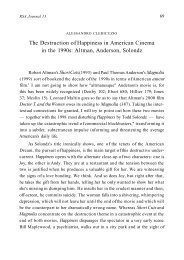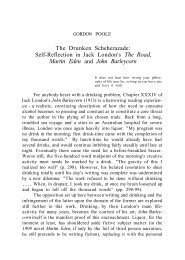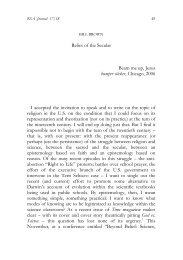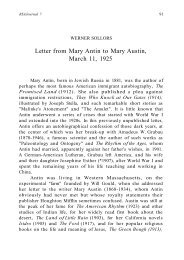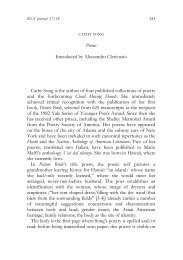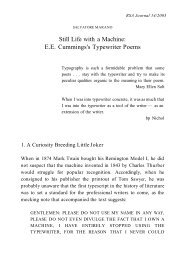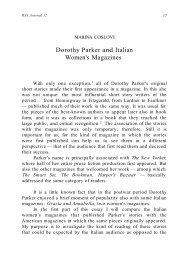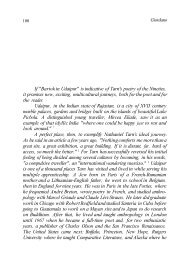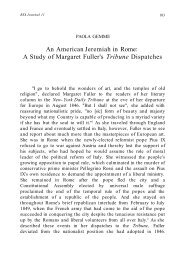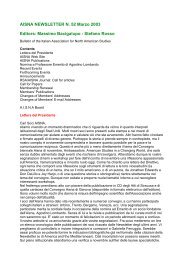Myth and Carnival in Robert Coover's The Public Burning - aisna
Myth and Carnival in Robert Coover's The Public Burning - aisna
Myth and Carnival in Robert Coover's The Public Burning - aisna
- No tags were found...
You also want an ePaper? Increase the reach of your titles
YUMPU automatically turns print PDFs into web optimized ePapers that Google loves.
RSA Journal 313Scenery, perspectives, optical effects, trompe l'oeil, magnified scenes(Foucault 113)<strong>and</strong> <strong>Coover's</strong>camera platforms ... backstage VIP passageways, wedd<strong>in</strong>g altars, sideshows,special light <strong>and</strong> sound systems... traffic ... rerouted so as to causemaximum congestion <strong>and</strong> rage, a solid belt of fury at the periphery be<strong>in</strong>gan essential liturgical complement to the melt<strong>in</strong>g calm at the center. (PB5)For both Foucault <strong>and</strong> Coover, power is a series of elements that seemto cohere <strong>in</strong>to a semblance of Unity, Totality, <strong>and</strong> Truth.More specifically, the transformation of history <strong>in</strong>to spectacle<strong>and</strong> of the human body <strong>in</strong>to theatrical agent are common traits d'unionbetween Foucault's Discipl<strong>in</strong>e <strong>and</strong> Punish <strong>and</strong> <strong>Coover's</strong> <strong>The</strong> <strong>Public</strong>Burn<strong>in</strong>g. In both works, the execution of the outlaw enacts thetriumphal epiphany of a power that stages the history of its ownpotency; the body of the condemned becomes the text <strong>in</strong> which Power<strong>in</strong>scribes its mythified magnificence. <strong>Public</strong> execution serves power as aritual of regeneration <strong>and</strong> rebirth, "just what the troubled nation needsright now to renew its s<strong>in</strong>k<strong>in</strong>g spirit. Someth<strong>in</strong>g archetypal, tragic,exemplary" (PB 4).In this context, <strong>Coover's</strong> "exemplarity" may well co<strong>in</strong>cide, asJackson Cope has suggested, with Bakht<strong>in</strong>'s notion of "carnival," thatis, with a virtual subversion of "reality" <strong>and</strong> the <strong>in</strong>version of rules,authority <strong>and</strong> structures. <strong>The</strong> "dialogic" element of <strong>Coover's</strong> metafictionopens a breach between, on the one h<strong>and</strong>, the monologism ofpower with its epiphanies—history, documents on the Rosenberg'scase, Uncle Sam's fiction-mak<strong>in</strong>g <strong>and</strong> theatrical stag<strong>in</strong>g—<strong>and</strong>, on theother, a "carnivalistic" subversion of monologism aim<strong>in</strong>g at suggest<strong>in</strong>gthat "there are always other plots, other sett<strong>in</strong>gs, other <strong>in</strong>terpretations"(Coover 1983, 68). In <strong>The</strong> <strong>Public</strong> Burn<strong>in</strong>g, this carnivalizationf<strong>in</strong>ds its propitiation <strong>in</strong> the moment when Ethel Rosenberg's body—sacrificial victim of the American myth—loses its consistency tobecome two-dimensional, someth<strong>in</strong>g written on the page of a fiction,its consistency <strong>and</strong> three-dimensionality be<strong>in</strong>g only a trompe l'oeil,"like one of those trick images <strong>in</strong> a 3-D movie... " (PB 517). Push<strong>in</strong>g



